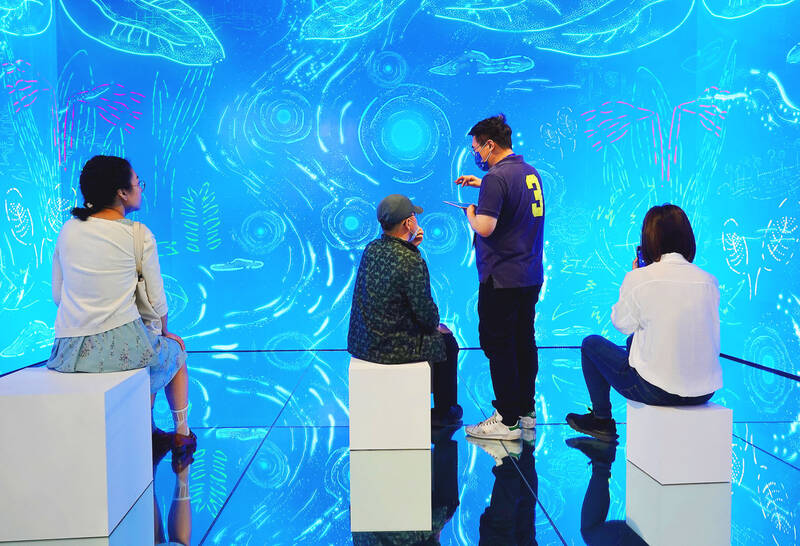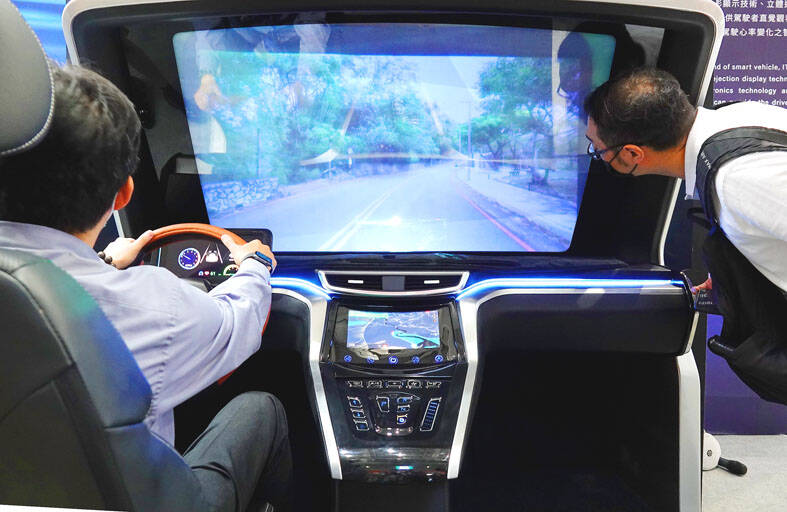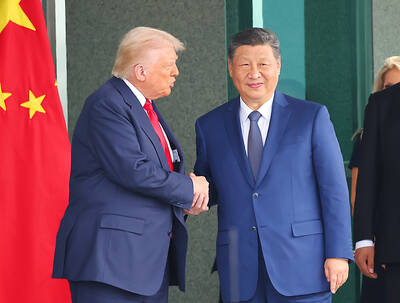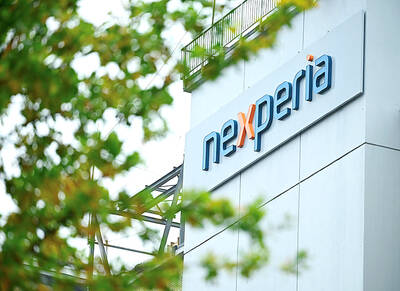LCD panel maker AUO Corp (友達) yesterday said it plans to convert an older-generation LCD fab in Taoyuan’s Longtan District (龍潭) into a microLED panel production site in preparation for rapid uptake of the new display technology in 2025.
The Longtan plant, dubbed Fab 5A, makes notebook computer panels, AUO said, adding that it would allocate 8.5-generation production capacity for notebook computer panels.
“MicroLED technology is highly linked to the front-end process of LCD technology, so we are preparing to upgrade an existing plant to produce the next-generation display technology,” AUO chief executive officer Frank Ko (柯富仁) told a media briefing in Taipei.

Photo: CNA
“The 5A fab and other factories in Longtan would be part of our future deployment of next-generation display technology,” Ko said.
AUO started converting its production lines in Longtan about two years ago.
The company’s microLED technology is to enter mass production in the second half of this year, it said.

Photo: CNA
That would make it one of two panel makers in the world capable of producing microLED panels this year, joining Samsung Electronics Co of South Korea.
AUO’s first microLED panels would be 1.39-inch panels used in smartwatches, it said.
Bigger panels used in TVs and public information displays would be available next year, it said.
The microLED panels would also be used in vehicle displays such as central information displays and smart cockpits, with mass production scheduled for 2025 or 2026 due to longer certification periods, AUO said.
As more companies join the microLED supply chain, AUO expects manufacturing costs to drop 50 percent every two years, a rule similar to Moore’s law in the semiconductor industry, AUO chairman Paul Peng (彭?浪) said.
Fairchild Semiconductor International Inc and Intel Corp founder Gordon Moore in 1965 said that the number of transistors in an IC doubles about every two years.
AUO said it estimates that the manufacturing cost of microLED panels would reach a sweet spot in 2025.
Mini LED panels remain much more pricey than their LCD counterparts, it said.
AUO allocates about 30 percent of its 2,000 research engineers for the development of the next-generation display technology to deliver higher resolution and better color performance than LCD technology, it said.
Separately, Innolux Corp (群創) said it is working with customers to develop microLED panels, without saying when it is to deliver its first such product.
The company said it is considering converting a 5.5-generation LCD fab to a microLED panel production base.
Other options include using the capacity to produce niche products, displays used in 5G or 6G devices or antenna for communicating with low Earth orbit satellites, Innolux said.
The 5.5-generation fab is entering a “green” idle state as the company phases out some commodity products, Innolux chairman Jim Hung (洪進揚) said.
The company is adjusting its manufacturing capacity for products with better margins and has transformed a 3.5-generation fab into a production site for advanced chip packaging technology, the company said.
Innolux also uses a 4-generation LCD manufacturing fab to produce X-ray sensors and a 4.5-generation fab to make e-paper displays, the company added.
The company said it expects to launch a project with Vedanta Group in June after receiving Indian government approval for subsidies.
Innolux has signed an agreement with Vedanta to help the Mumbai-based firm build a flat-panel production line in India and help license its intellectual property.

RUN IT BACK: A succesful first project working with hyperscalers to design chips encouraged MediaTek to start a second project, aiming to hit stride in 2028 MediaTek Inc (聯發科), the world’s biggest smartphone chip supplier, yesterday said it is engaging a second hyperscaler to help design artificial intelligence (AI) accelerators used in data centers following a similar project expected to generate revenue streams soon. The first AI accelerator project is to bring in US$1 billion revenue next year and several billion US dollars more in 2027, MediaTek chief executive officer Rick Tsai (蔡力行) told a virtual investor conference yesterday. The second AI accelerator project is expected to contribute to revenue beginning in 2028, Tsai said. MediaTek yesterday raised its revenue forecast for the global AI accelerator used

TEMPORARY TRUCE: China has made concessions to ease rare earth trade controls, among others, while Washington holds fire on a 100% tariff on all Chinese goods China is effectively suspending implementation of additional export controls on rare earth metals and terminating investigations targeting US companies in the semiconductor supply chain, the White House announced. The White House on Saturday issued a fact sheet outlining some details of the trade pact agreed to earlier in the week by US President Donald Trump and Chinese President Xi Jinping (習近平) that aimed to ease tensions between the world’s two largest economies. Under the deal, China is to issue general licenses valid for exports of rare earths, gallium, germanium, antimony and graphite “for the benefit of US end users and their suppliers

Dutch chipmaker Nexperia BV’s China unit yesterday said that it had established sufficient inventories of finished goods and works-in-progress, and that its supply chain remained secure and stable after its parent halted wafer supplies. The Dutch company suspended supplies of wafers to its Chinese assembly plant a week ago, calling it “a direct consequence of the local management’s recent failure to comply with the agreed contractual payment terms,” Reuters reported on Friday last week. Its China unit called Nexperia’s suspension “unilateral” and “extremely irresponsible,” adding that the Dutch parent’s claim about contractual payment was “misleading and highly deceptive,” according to a statement

Artificial intelligence (AI) giant Nvidia Corp’s most advanced chips would be reserved for US companies and kept out of China and other countries, US President Donald Trump said. During an interview that aired on Sunday on CBS’ 60 Minutes program and in comments to reporters aboard Air Force One, Trump said only US customers should have access to the top-end Blackwell chips offered by Nvidia, the world’s most valuable company by market capitalization. “The most advanced, we will not let anybody have them other than the United States,” he told CBS, echoing remarks made earlier to reporters as he returned to Washington